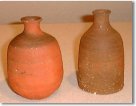|
 
 
Top (L to R) Kato Kozo and Yagi Kazuo
Bottom (L to R) Kaneshige Toyo and Fujiwara Yu
Yakishime refers to high-fired unglazed stoneware
Famous examples of yakishime are:
The key Yakishime elements are firing, clay, and form. Basically two types of kilns are used: (1) Anagama or single-chamber tunnel kiln; (2) Noborigama or multi-chambered climbing kiln. Temperatures can reach 1350 celsius (some push it up to 1500 degrees) and a kiln can be fired for up to sixty days.
Clay, like rice for sake, dictates the "flavor" of the pot - this is termed "tsuchi-aji" or clay flavor. In a yakishime pot tsuchi-aji is very important.
Like sake rice, many of the impurities of the clay are removed. Some potters, however, like a rougher clay and leave in small stones that sometimes burst out on the surface during firing. This is called ishihaze (see first two photos above).
|



